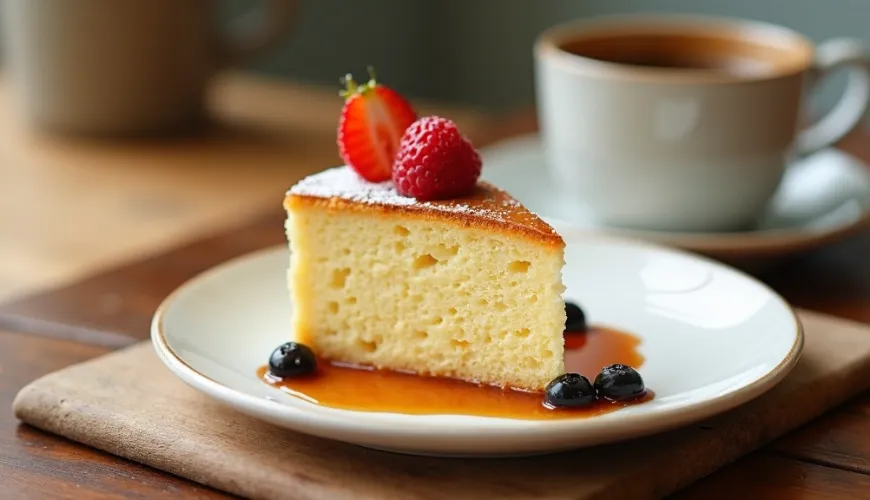
Discover the Magic of Japanese Cake and Its Secret to Lightness

The Secret of Lightness - Why the Whole World Fell in Love with the Japanese Sponge Cake
In the kitchen where simplicity meets precision, recipes are created that captivate with both taste and presentation. One such treasure is the Japanese sponge cake, often referred to as the "cloud cake" – a cake so light that it is likened to a cloud. While Europe indulges in layers of buttery creams and heavy bases, Japanese confectionery takes a different path. It focuses on airiness, delicacy, and attention to detail. And this is exactly why the Japanese cake wins the hearts of gourmands across continents.
In an era when the world is turning to minimalism, the Japanese cake with 3 ingredients has gained immense popularity, proving that you can achieve maximum effect with minimal effort. But what is the story behind this cake and why do so many people want to bake it at home?
Lightness as a Philosophy
The Japanese sponge cake, sometimes referred to as the Japanese cheesecake, has its roots in the 1940s. It was created out of a desire to make an alternative to the classic American cheese cake, but one that fits the Japanese taste – lighter, gentler, and less sweet. However, it's not a cheesecake in the true sense of the word, but a hybrid between sponge, soufflé, and traditional cake. It isn't heavy, it doesn't cause bloating, it's not overly sweet – and yet it is completely captivating.
The secret to its success lies in the technique. The foundation is the careful separation of egg whites and yolks, gentle folding, and baking in a water bath. The result is a texture that literally melts in your mouth. It's no wonder they say Japanese cuisine is the art of detail – and in this case, it holds true doubly so.
Japanese Cake in the Age of Social Media
Instagram and TikTok have made this dessert a phenomenon. Users share videos where the cake literally jiggles at the lightest touch of a spoon. And it's exactly this "dancing" texture that fascinates people. Combined with the fact that the Japanese cake with three ingredients can be made by practically anyone at home, it has become a viral hit.
The recipe is almost unbelievably simple: eggs, cream cheese, and white chocolate. That's it. No flour, no butter, no lengthy preparations. Just three ingredients that come together to create something much greater than the sum of their parts. This recipe became especially popular during the pandemic when people were looking for simple ways to enjoy something special at home.
"Simplicity is not about deprivation, but about focusing on the essentials," says Japanese chef Hiroyuki Sakai. And that's precisely the magic of this recipe.
Step-by-Step Recipe for Japanese Sponge Cake
Whether you opt for the more complex version with flour and milk or prefer the minimalist Japanese cake with 3 ingredients, the basic principles remain the same – separate the eggs, beat the egg whites until stiff peaks form, and bake slowly, ideally in a water bath.
Here is a favorite recipe for the Japanese sponge cake in its more traditional form:
Ingredients:
- 6 eggs
- 140 g sugar
- 100 ml milk
- 60 g butter
- 90 g cake flour
- 1 teaspoon vanilla extract
- pinch of salt
Method:
- Preheat the oven to 160 °C. Line a cake pan with baking paper and wrap the outside well with aluminum foil (as it will be baked in a water bath).
- Separate the yolks from the whites. Place the whites in a clean bowl and set aside.
- Melt the butter with milk in a water bath. Let it cool slightly and mix with the yolks, vanilla, and sifted flour.
- Beat the egg whites with a pinch of salt and gradually add sugar until a glossy, stiff meringue forms.
- Gently fold the egg whites into the yolk mixture in parts, keeping the batter as airy as possible.
- Pour into the prepared pan. Bake in a water bath for about 60–70 minutes. After baking, let it cool in the oven with the door slightly ajar to prevent the cake from collapsing.
The result is a cake as soft as moss, light as a breeze, yet full of flavor. It pairs well with morning coffee, as an afternoon dessert, or as a festive treat.
Why Do the Japanese Love Sponge Cakes?
Interestingly, sponge desserts have a long tradition in Japan. As early as the 16th century, Portuguese missionaries brought the recipe for "pão de ló" – a light egg cake, which became the precursor to today's Japanese castella, another type of sponge. The Japanese grew so fond of this baking style that they gradually adapted it to their sense of harmony and aesthetics.
The Japanese sponge cake is thus not just a dessert but also an expression of the cultural approach to food – food should be not only tasty but also visually appealing and light on the body. In a country where health and balance play a key role, it is no surprise that desserts that do not burden the body and bring joy are preferred.
When Simplicity Isn't Boring
You might wonder – can something as simple as a cake made of eggs, cheese, and chocolate really excite me? Just look at the success of this recipe on social media, where it has millions of views. Where others use dozens of ingredients, the Japanese cake relies on the purity of flavors and textures.
Compared to classic cakes that often dominate patisseries in Europe, the Japanese cake seems like it's from another world. It is quiet, unobtrusive, but unforgettable. Just like Japanese calligraphy – every stroke has its meaning, nothing is superfluous.
Moreover, this cake is naturally gluten-free if you choose the flourless version, making it ideal for anyone following a gluten-free diet or trying to avoid unnecessarily heavy desserts.
A Real-Life Example - What One Cake Can Do
Imagine this scenario: a young couple decides to invite friends over for dinner. They want to prepare a homemade menu, but the dessert is a concern – they don't want anything too complicated and patisserie cakes are not their strong suit. They find a recipe for the Japanese cake with three ingredients, start baking, and the result? Guests ask for the recipe, take pictures of the cake, and by the end of the evening, not a crumb is left.
This story is not unique – many people have had similar experiences, creating a culinary masterpiece on their first attempt. And that's the charm of the Japanese dessert: accessibility, simplicity, and impact.
When we talk today about returning to the essence, about naturalness, and about less being more, the Japanese sponge cake is the perfect symbol of this trend. It's not necessary to have a complex recipe to create something that delights all the senses. In today's hectic times, when we seek calm and a return to simplicity, such a cake becomes a small but valuable gesture of care and joy.

